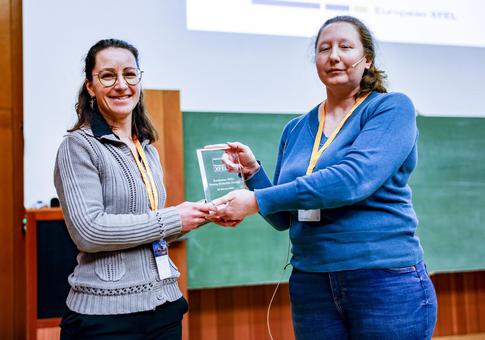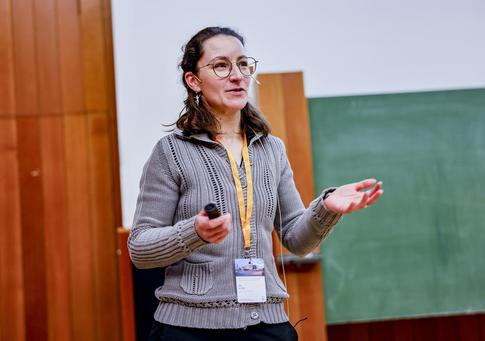XFEL: 2023 Young Scientist Award winner announced
2023 Young Scientist Award winner announced

Elke de Zitter (L) receives Young Scientist award from Andrea Eschenlohr, Chairwomen of the European XFEL User Organisation (R)
“The European XFEL Young Scientist Award highlights the future potential of young scientists working in X-ray laser science, outlining the talent, hard-work and dedication of the early-career researchers within our user community,” says Sakura Pascarelli, Scientific Director at European XFEL. “It is an opportunity to highlight the impact of new research done by talented young researchers, as well as to showcase the large collaborative efforts that are required for research at European XFEL.”
De Zitter gave insights into her research at a talk during the users’ meeting 2023, explaining her work and the contribution of European XFEL data in her research. She also provided us with a short interview.
Can you tell us about your research?
The focus of my research is on data processing of time resolved crystallography or, more generally, serial crystallography. We want to understand the link between protein structure, dynamics and function. X-ray crystallography has been around for some time but it provides a static structure, so we want to see a protein in action. In this way, we can understand [the protein] further, and maybe also be able to mutate the protein to alter its behavior.
A big part of my research is writing and developing a program for data analysis. The program I wrote is called Xtrapol8. The Xtrapol8 software is important for any kind of time resolved study. When you trigger a reaction in a crystal actually most of the proteins in the crystal do not change. They just remain in their initial state, so it’s only a tiny fraction of proteins that actually start moving. That means that if you look at the crystal on average, you just end up with the initial state, instead of the state you’ve tried to trigger! Xtrapol8 tries to extract that specific signal of the triggered or ‘intermediate’ state, in order to calculate the structure of the protein in that state.
What do you mean when you say mutate the proteins – how will this make them better?
In our lab we work on specific topics. One of them is that we work on mosquitocidal proteins; these are proteins that actually kill mosquitoes. By understanding how they work, how they crystallise, we ask ourselves if we can make a cocktail of these proteins, or how we can activate these proteins better, so that we don’t need as much of them in order to kill mosquitos.
We also work on light-sensitive proteins. If you want to use them in purposes like microscopy, these proteins need to have specific properties that are good for microscopy experiments.
Or for example, we work on esterases, that naturally “hydrolyse” [break down] certain molecules, but we want them to work on other molecules that are potentially dangerous for us and so, if we can, we want to find a way to alter the behavior of these proteins.
What do you think the relevance of your research is for the general public?
For certain things understanding is important, for instance proteins that are involved in diseases. But for other things, the aim is that we can make [these proteins] useful for other experiments or for industry. It’s a downstream process.
So, for example, on mosquitocidal proteins. There already exist biological ways to control mosquito populations, but they are much more expensive than the chemicals, although the chemicals do not only degrade the mosquitos; they also degrade the bees, the fish, and so on. Really, the biosystem. But the only thing that interests us as humans is controlling mosquitos because they carry a lot of diseases. In this sense, it would be better to have control such that you only attack mosquitos but for now it’s just much more expensive, so on an industrial scale it’s difficult.
What was the importance of European XFEL in your research?
It was very important for two main reasons. First, I’ll come back to the mosquitocidal proteins. These are naturally crystalline proteins and you cannot dissolve them and recrystallize them. They’re grown inside bacteria so they’re very, very small. The brilliance of the European XFEL was really what was required to get high resolution diffraction data so we could solve the structures. Synchrotrons are not brilliant enough. In order to capture these structures, it was clear we needed an XFEL.
The second reason was the specific pulse structure of an XFEL. We can do time-resolved crystallography that lets us look at the dynamics of the proteins.
What future directions do you see for your research?
My main project is still the optimisation of [Xtrapol8], but also looking into the function of esterases, to change their behavior from breaking down natural substrates towards more interesting applications.
We also have some [new Xtrapol8] functionalities in mind. One of our aims is that it’s an easy program that everyone can use, and we think more and more groups will be interested in carrying out time-resolved studies. Our program has to evolve over time so that users are happy.

Elke de Zitter giving her award lecture to the European XFEL Users' Meeting
Do you have any words of advice for other young scientists in structural biology or generally?
It is somewhat difficult to give advice because my trajectory was my trajectory other people may have different opinions.
I think it's a good idea to find opportunities [that allow you] to keep on developing. I was doing my PhD on crystallography and also studies of fluorescent proteins. So, for my next post-doc I said “absolutely no fluorescent proteins” because I already knew a lot about it. It's all about finding good opportunities to keep developing your skills and what you like. Especially find something that you like, because it’s not always a 9 to 5 job.
And lastly, is there anyone you want to thank?
First of all, I would like to thank Jacques-Philippe Colletier for the nomination. Secondly, I would also like to thank him for taking me onboard in his research team, first as a postdoc and then as a permanent member. He taught me a lot and we are working together on interesting research topics.
Secondly, I wish to thank Peter Dedecker, Luc Van Meervelt and William Shepard, who supervised my PhD and first postdoc and who played an indisputable role in my development as a researcher. Finally, I want to thank Martin Weik and the whole DYNAMOP team at the IBS for the nice collaboration and support.
[Interview: A. Chandran]
Press Contact
Bernd Ebeling
E-mail: bernd.ebeling@xfel.eu
Tel: +49-40-8998-6921
